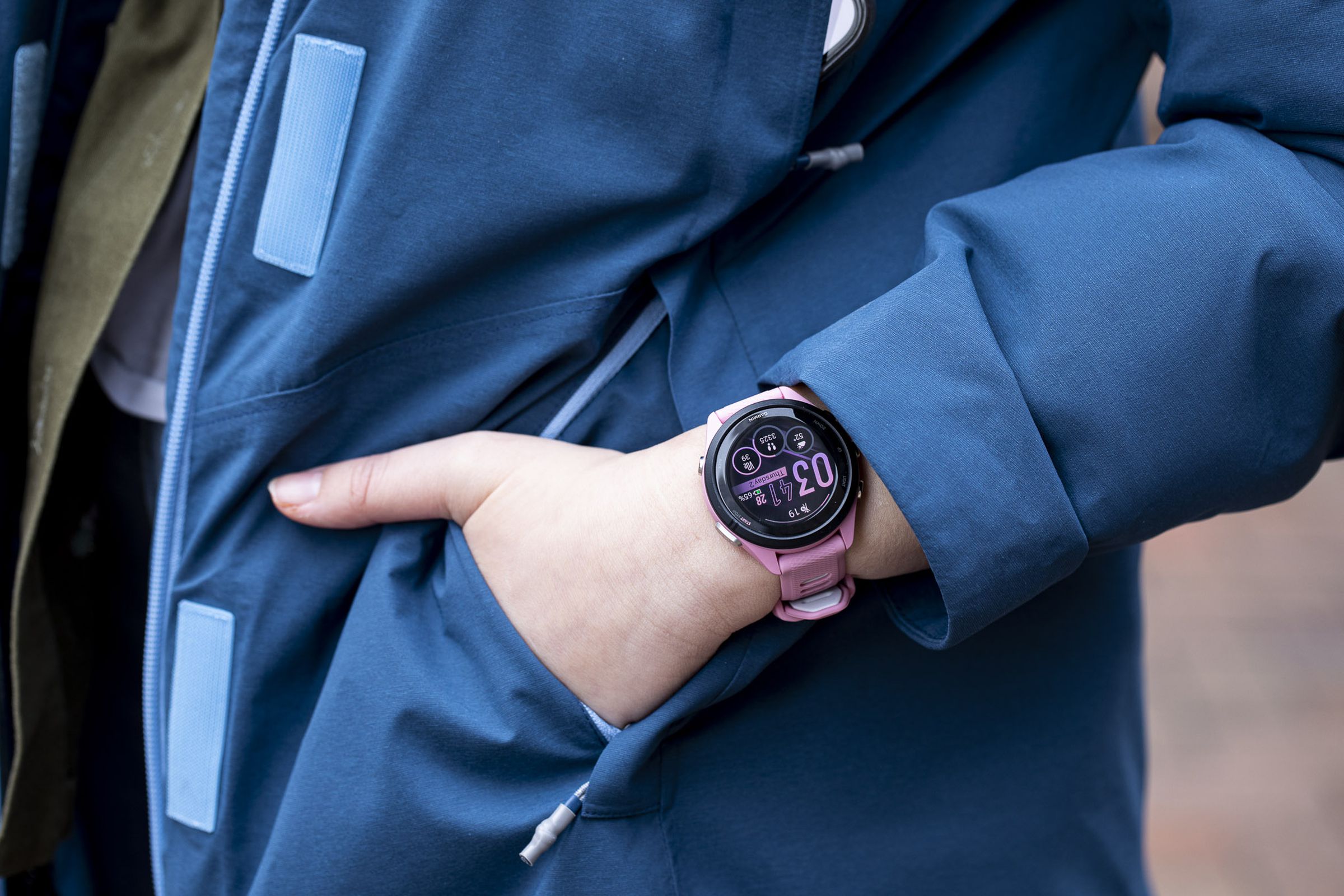Garmin may be best known for its hardcore fitness watches, but it’s got an extensive line of lifestyle offerings, too.
Few brands are as synonymous with outdoor sports as Garmin. You’ll find these fitness trackers and smartwatches on dozens of wrists at any 5K, marathon, or Ironman. You’ll also find Garmin devotees among divers, thru-hikers, golfers, kiteboarders — you name it. But these devices aren’t just for athletes. The company’s made significant strides in its lifestyle offerings, so regardless of your fitness level, there’s a Garmin for everyone.
If you’re coming from a more traditional smartwatch, Garmin’s core strengths lie in fitness, GPS, adventuring, and durability. These are hardy devices that are meant to withstand the elements and last weeks on a single charge. Several models come with offline maps, advanced navigational features, and more training metrics than any other platform. And although many wearable companies have begun rolling out subscriptions, Garmin has publicly stated it has no intention of charging its users extra. That’s a good thing since Garmin devices tend to be on the pricier side.
Garmins aren’t too shabby on smarts, either. While more fitness-focused than anything from Apple, Google, or Samsung, there’s enough to get you the basics like notifications and then some. For example, most Garmins have fall detection and safety features, and several of the latest Garmins recently got an FDA-cleared EKG feature. (You’ll need a phone on hand, however, as only one Garmin model has cellular connectivity.) Many Garmin devices also support offline music playback and come with a small third-party app ecosystem.
There are a lot of Garmin watches to choose from. No, seriously, there are six major lineups, and each has a multitude of models. But no worries — I test several Garmins every year and can help point you in the right direction.
The best Garmin for runners
Garmin’s midrange Forerunner watch adds a new OLED display, a week’s worth of battery life, and dual-frequency GPS for better accuracy.
Sizes: 42mm w/ 18mm straps; 46mm w/ 22mm straps / Weight: 39g (42mm); 47g (46mm) / Battery life: Up to 15 days (42mm); 13 days (46mm) in smartwatch mode / Display type: OLED touchscreen / GPS: All-systems GNSS and dual-frequency GPS / Connectivity: Bluetooth, Ant Plus, Wi-Fi / Water resistance: 5ATM / Music storage: 8GB
Garmin has many running watches, and a lot of them are great. But the Forerunner 265 or 265S (if you have petite wrists) strikes an excellent balance between price, feature set, battery life, and a vibrant OLED display.
That said, the Forerunner 265 / 265S is a bit of an odd duck. It comes a mere nine months after its predecessor, the Forerunner 255, and is, in many ways, pretty much the same watch. The main difference is the 265 has an OLED display compared to the 255’s memory-in-pixel screen. Usually, that means worse battery life, but in this case, we got about a week on a single charge with the always-on display enabled. Without it, you can get up to 15 days. Given that OLED is easier to read and just, well, looks nicer, that gives the 265 lineup an edge over the 255.
The 265 also has dual-frequency GPS (also known as multi-band). The gist is you get much more accurate maps in challenging environments like cities and dense forests because you can access both the L1 and L5 satellite frequencies. And even with dual-frequency GPS enabled, you still don’t lose a whole lot of battery life. I wore it during a half marathon with that and the AOD enabled, and I still had over 80 percent battery by the time I got home. This is also an excellent price, as the majority of multi-band GPS watches cost well over $600.


It doesn’t have all of Garmin’s training features, but it’s got what you’ll need to run anything from a 5K to a full marathon. That includes a Race Predictor, which gives you an estimate of what your best time would be based on your actual training. You can also use PacePro to figure out your pacing strategy for a race. You also get Garmin’s Training Readiness feature to help gauge load and recovery, Garmin Coach plans, and a host of running form metrics. It also supports offline music and safety features like fall detection.
The only thing the Forerunner 265 / 265S “lacks” is advanced mapping. (It still has trackback, point-to-point navigation, and real-time breadcrumb trail support, however.) If you frequently hike or run trails, you may want to consider the next step up with the Forerunner 965. The 255 is also an option if you’d like to save an extra $100 and don’t mind a less fancy screen.
And while the Forerunner 265 / 265 is geared toward runners, it’s a capable training watch for triathletes, cyclists, hikers — really anyone who wants a feature-rich, lightweight, and durable multisport watch without paying top-of-the-line prices.
The best Garmin for endurance sports
The Garmin Epix Pro comes in three sizes, includes a handy flashlight, and has multiband GPS. Plus, it still lasts over a week on a single charge. Read our review.
Sizes: 42mm w/ 20mm straps; 47mm w/ 22mm straps; 51mm w/ 26mm straps / Weight: 42mm: 63g stainless steel, 58g titanium; 47mm: 78g stainless steel, 70g titanium; 51mm: 98g stainless steel, 88g titanium / Battery life: 42mm: up to 10 days (4 with AOD); 47mm: up to 16 days (6 with AOD); 51mm: up to 31 days (11 with AOD) / Display type: OLED / GPS: All-systems GNSS and dual-frequency GPS / Connectivity: Bluetooth, Ant Plus, Wi-Fi / Water resistance: 10ATM / Music storage: Up to 32GB
The Epix Pro will get you every fitness feature that Garmin has to offer. And I mean everything. It would frankly be easier to tell you what the Epix Pro does not have: EKGs and some things that are limited to LTE smartwatches, like the ability to make calls. (Though the Pro adds a new sensor array that makes EKGs a possibility down the line.) Otherwise, you’ve got topographical maps, turn-by-turn navigation, and more training metrics than even a seasoned triathlete would know what to do with.
The Pro is more size-inclusive than the standard second-gen Epix, which only comes in 47mm. You can get the Pro in that size, too, but it also comes in 42mm and 51mm. This was a major complaint I had with the second-gen Epix last year, and you love to see companies actually take this sort of thing seriously. The best part is the Pro models start at the same price as the regular Epix did. You’ll have to pay $100 extra for materials like titanium and sapphire crystal, but that’s also true of the standard Epix.


That said, it muddies the waters if you’re trying to pick between the Epix Pro, Fenix 7, or the Fenix 7 Pro. The main difference is the Epix watches have OLED displays. One reason I prefer OLED is that they’re much easier to read indoors — wheremost of us spend the majority of our time. The Fenix 7 series’ memory-in-pixel displays (plus solar charging if you opt for it) allow for weeks and weeks of charge, but the smallest Epix Pro can get around 10 days with normal usage. The 47mm and 51mm Pro models can go longer between charges due to bigger batteries, but I felt that the 42mm has enough juice to satisfy most use cases. Garmin also has so many battery-saving modes and options that I highly doubt this will ever be an issue.
But really the winning feature is the hands-free flashlight. It’s so useful in my day-to-day life, and all you have to do is double-press a button. It’s as bright as your smartphone, comes with a red light option if you want something easier on the eyes, and can act as a strobe in an emergency situation. The Fenix 7 Pro watches also have a flashlight, but the combo with the OLED display gives the Epix the edge — and it’s why I currently recommend it over the Fenix lineup.
But if you’re set on the Fenix’s extra battery life, I recommend the 7 Pro over the standard 7 for a few reasons. Its MIP display is slightly brighter, all sizes have the flashlight, and, like the Epix Pro, it has an updated sensor array. These are spendy watches, however. If you’ve got some time and savings are your top priority, then I recommend keeping an eye out for sales. We’re heading into peak smartwatch launch season — which means older models like the standard Fenix 7 line will be discounted as retailers try to reduce inventory.
The best Garmin on a budget
Garmin’s entry-level hybrid smartwatch looks like a Swatch at first glance. However, it sports a hidden OLED display that delivers notifications without sacrificing fitness tracking.
Sizes: 40mm w/ 20mm straps / Weight: 19g / Battery life: Up to 5 days / Display type: “Hidden” OLED touchscreen / GPS: Tethered GPS / Connectivity: Bluetooth, Ant Plus / Water resistance: 5ATM / Music storage: N/A
What I love most about the Vivomove Sport is it doesn’t look like what most people expect from a Garmin. It’s a hybrid smartwatch, which means it looks like a regular watch but can track fitness and deliver notifications. Garmin’s hybrids are also unique in that they all use an OLED display that stays hidden until you need it.
This is best suited for a casually active person who wants style and value in a lightweight package. Think wellness, more so than fitness. It gets you continuous heart rate monitoring and blood oxygen level monitoring and can even provide abnormal heart rate alerts. You also get access to more in-depth metrics like respiration rate, fitness age, stress, and Body Battery, which is Garmin’s tool for visualizing how well-rested you are. For smart features, you get all the basics, like notifications, alarms, and timers.


The Sport isn’t quite as full-featured as some other Garmins you’ll find on this list. For instance, you’re giving up built-in GPS in favor of tethered GPS through your phone. There are no contactless payments, nor is there a microphone or speaker for taking calls on the wrist. But this is a budget pick, and you get a lot, considering this is an entry-level gadget that could pass for a Swatch at a glance.
I don’t love that the battery life is short for a hybrid, at around three to four days. Even so, that’s still much better than what you’ll get on an Apple Watch or Wear OS 3 watch. If you’re willing to spend about $100 more, the $269.99 Vivomove Trend has more chic materials, gets you more screen real estate, and wireless Qi charging. Otherwise, this is a great lifestyle wearable that can serve as a classier alternative to your typical fitness band.
The best Garmin to replace a Fitbit
The Garmin Venu Sq 2 is a great replacement for a Fitbit smartwatch. Not only do they look similar, but the Venu Sq 2 has way more fitness features, long battery life, and no subscription.
Sizes: 40mm w/ 20mm straps / Weight: 38g / Battery life: Up to 11 days / Display type: OLED touchscreen / GPS: All-systems GNSS / Connectivity: Bluetooth, Ant Plus / Water resistance: 5ATM / Music storage: 4GB (for Music Edition)
If you were disappointed by the Fitbit Sense 2 and Versa 4, the Venu Sq 2 is the next best thing (and, in some ways, better).
At a glance, the Venu Sq 2 could easily be mistaken for an Apple Watch. On the wrist, you’ll notice it’s made of plastic, but it still looks quite chic and extremely lightweight. The screen is bright, easy to read, and looks better than any Versa or Sense ever did.
The feature set is also great for the price, with built-in GPS, a ton of watch faces, emergency safety features, and contactless payments. If you pay $50 more for the Music Edition, you’ll also get about 500 songs worth of storage, but we wouldn’t recommend it. This doesn’t have cellular connectivity and, therefore, isn’t truly standalone. You’ll most likely be carrying your phone with you anyway.


As for health features, the Venu Sq 2 basically has everything you’d get on a Versa or Sense smartwatch but with Garmin’s treasure trove of metrics as well. That includes heart rate tracking, blood oxygen tracking, intensity minutes (how much moderate exercise you get in a week), stress tracking, hydration tracking, respiratory rate, period tracking, and Garmin’s recovery feature, Body Battery. As far as fitness goes, you also get access to Garmin Coach, which provides free 5K, 10K, and half marathon training plans. You love to see it.
Another big leg-up Garmin has over Fitbit? None of these features or metrics are locked behind a paywall.
The best Garmin smartwatch
The Garmin Venu 3S adds a new heart rate sensor, a wheelchair mode, and much-improved sleep tracking and nap detection.
Sizes: 41mm w/ 18mm straps; 45mm w/ 22mm straps / Weight: 40g for the 3S; 47g for the 3 / Battery life: Up to 10 days for 3S; 14 days for 3 / Display type: OLED touchscreen / GPS: GPS, GLONASS, GALILEO / Connectivity: Bluetooth, Ant Plus, Wi-Fi / Water resistance: 5ATM / Music storage: 8GB
Garmin has shored up the smarts in its watches over the past few years, and the Venu 3 series is the smartest of the bunch.
The Venu 3 series comes in two sizes: 41mm and 45mm. Like the Venu 2 Plus, it has a microphone and speaker.You can take calls directly from the wrist as well as issue commands to your phone’s digital assistant via Bluetooth. It’s not the same as having Siri, Bixby, Amazon Alexa, or Google Assistant built directly into the watch, but it’s a clever workaround that works well for hands-free control. It also supports safety features like fall detection and live tracking as well as contactless payments.


Like other OLED Garmins, the display is both vibrant and easy to read. As for health and fitness, you get a nice mix of basic and more advanced features and metrics. It has Garmin’s latest heart rate sensor, which enables FDA-cleared EKG and AFib detection features. Overall, it leans a bit more on the wellness and health side of things, with intensity minutes, blood oxygen monitoring, sleep tracking, period tracking, abnormal heart rate alerts, and stress tracking. As for training, you still get built-in GPS, VO2 Max, heart rate zones, respiration rate, and downloadable training plans via Garmin Coach.
New to the 3 and 3S is a sleep coach that factors in metrics like heart rate variability and recent activity to determine your sleep needs. It also finally adds nap detection, a feature that’s been long overdue for the Garmin platform. The Venu 3 series also adds audio-guided meditation sessions, and you can view how these sessions directly impact your metrics. From an accessibility standpoint, this also adds a new wheelchair mode.
This is the Garmin for you if you want the platform’s in-depth training without sacrificing the productivity of a smartwatch. The main things it’s lacking are cellular options and a robust third-party app ecosystem. That said, it’s got Spotify, Amazon Music, and Deezer for offline listening. It’s also a good option if you’re fed up with MIP displays and want a smarter Garmin rather than a full-on smartwatch.
Update December 7th, 11:20AM ET: Swapped Garmin Venu 3 series for Garmin Venu 2 Plus in the best Garmin smartwatch category.









